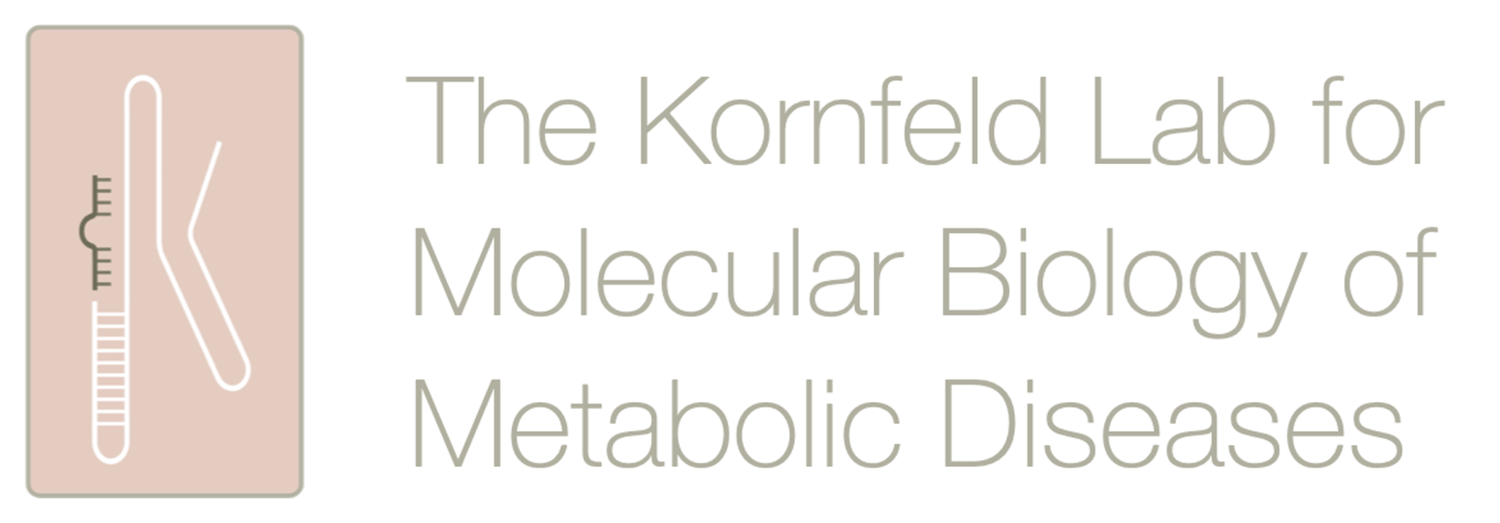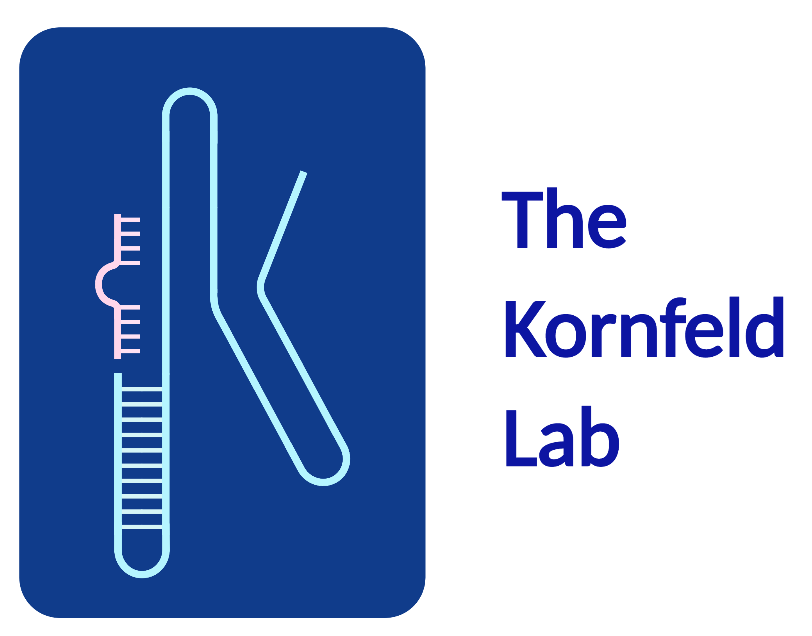Noncoding RNA Regulation of Metabolism
The Kornfeld Lab aims to understand how Noncoding RNAs are involved in obesity-mediated metabolic deterioration, for instance the loss of insulin sensitivity and the concurrent lipid accumulation in liver and other metabolic organs that ensue body weight gains. Particularly the ectopic accumulation of lipids in liver, referred to as Non-Alcoholic Fatty Liver Disease (NAFLD) is a rising clinical concern and consequence of the pandemic proportions of obesity and T2D world-wide.
We are also interested in understanding in how Noncoding RNA molecular networks instruct fat cells (adipocytes) to acquire catabolic (thermogenic, or 'brown adipocyte') or anabolic (calorie storing or 'white adipocyte') properties. This evolutionarily conserved plasticity of adipocytes is of clinical relevance given the anti-obesogenic properties of activated thermogenic adipocytes in laboratory mice, but also obese and T2D human patients.
In the following you will find more detailed information about published reports from our lab where we combined system-wide genomics approaches like RNA-Sequencing, the generation and metabolic analysis of transgenic mouse lines of Noncoding RNA loss- and gain-of-function, and human patient material to gain new mechanistic insights about regulation of Noncoding RNAs by Metabolism and vice versa.
Long Noncoding RNA regulation of Metabolic Disease
MAFG-lncRNA signaling links nutrient abundances to liver glucose metabolism
Long noncoding RNAs (LncRNAs) are exceedingly multifaceted Noncoding RNAs with a length of ≥200 nucleotides that exhibit a broad spectrum of mechanitic functions in gene regulation. Despite their stark tissue specificity and dynamic transcriptional regulation, our understanding of LncRNAs in disease pathogenesis is limited. Due to this discrepancy in understanding LncRNA, in contrast to protein-coding mRNA function, LncRNAs were paraphrased as ‘Dark matter of the genome’.
In a recent publication (Pradas-Juni et al 2020 Nat Commun) we showed that a high fraction of LncRNAs, but not protein-coding mRNAs, are repressed during dietary obesity and re-feeding, whereas that nutrient deprivation induced LncRNAs in mouse liver. Similarly, LncRNAs are lost in diabetic human liver. LncRNA promoter analyses, global cistrome and gain-of-function studies confirm that increased MAFG signaling activity during obesity curbs LncRNA expression. Silencing Mafg in hepatocytes and obese mice elicits fasting-like gene expression, improves metabolism, de-represses lncRNAs and impairs mammalian target of rapamycin (mTOR) activation.
We find that obesity-repressed LncRNA LincIRS2 is controlled by MAFG and observe that genetic and RNAi-mediated LincIRS2 loss causes elevated blood glucose, insulin resistance and aberrant glucose output in lean mice. Taken together, we identify a novel MAFG-lncRNA axis controlling hepatic glucose metabolism in health and metabolic disease.
Our data also suggest that competition between NRF1/NFE2L1 and MAFG is important for liver physiology: As found for MAFG gain-of-function, NRF1/NFE2L1 inactivation in the liver down-regulated genes involved in cholesterol to bile acid conversion. This suggests that, whereas NRF1/NFE2L1 suppresses inflammation and promotes bile acid synthesis, MAFG overexpression induces hepatic inflammation and suppresses bile acid conversion, in addition to suppressing key regulatory lncRNAs such as LincIRS2
(Illustration generated using Biorender)
MicroRNA gene regulation in Metabolic Disease:
Maturity Onset Diabetes of the Young 5 (MODY5) post-transcriptional regulation by miR802-Hnf1b:
MicroRNAs (miRNAs) are short, 21-24 nucleotide long Noncoding RNAs that modulate stability or the translational capability of mRNA targets. According to miRNA:mRNA prediction algorithms, human and mouse genomes encode >1000 miRNAs, targeting hundreds of protein-coding mRNAs each. With ≥ 60% of mRNAs predicted to be regulated by miRNAs silencing, the regulatory spectrum of miRNA regulation is enormous. Historically, most basic and translational studies focussed on elucidating transcriptional mRNA networks underlying cellular and systemic metabolic regulation, yet the magnitude of post-transcriptional gene silencing by miRNAs in metabolism research was less systematically investigated.
Using genetic and nutritional mouse models of obesity and type 2 diabetes (T2D), we identified and molecularly investigated a liver-selective miRNA termed miR-802. We demonstrated that induction of miR-802 by obesity deteriorated glucose metabolism in liver, partly by post-transcriptional silencing of Monogenic Diabetes of the Young (MODY) 5 gene Hepatocyte Nuclear Factor 1 Beta (Hnf1b, Kornfeld et al Nature 2013 and Commentary on the article here). Excessive miR-802-Hnf1b signaling caused hyperglycemia in miR-802 overexpressing mice, and presumably T2D patients. Using LNA Gapmer inhibitors targeting miR-802, we improved metabolic homeostasis in obese mice with little discernable side-effects. We therefore believe that this proof-of-concept study could serve as roadmap for the identification of tissue-specific and disease-associated microRNAs, supporting the notion of designing and applying Noncoding RNA loss-of-function regimens for the treatment of Metabolic Diseases in the future.
Regulation of adipose tissue function by microRNA processing
Weight intervention aproaches includes reductions in calorie intake or surgical interventions, which nonetheless often fail to lower body weight due to metabolic adaptations in energy expenditure and food intake. Opposing approaches aiming at increasing metabolic rates are less accompanied by adaptive processes and thus harbor a high potential in anti-obesity treatment. Due to its high metabolic activity, even small amounts of brown adipose tissue (BAT) are sufficient to increase metabolic rates with estimates positing that only 50g of additional BAT would combust 20% calories per day in humans extra. Identifying Noncoding RNA signaling circuits controlling BAT differentiation, activation and function is therefore of high clinical relevance.
In a recent study (Oliverio et al 2016 Nat Cell Biol), we found that aging- and obesity-associated dysfunction of brown adipose tissue coincides with global miRNA down-regulation due to reduced expression of microRNA processing enzyme Dicer1. Adipose-specific Dicer1 knockout aggravated obesity-derived deterioration of glucose metabolism. Next-Generation Sequencing identified miR-328 as a regulator of BAT differentiation: Reducing miR-328 blocked brown adipocyte commitment, while miR-328 over-expression drove BAT differentiation and impaired muscle progenitor commitment via silencing of the cell surface protease Beta-Secretase BACE1.
These experiments reveal Dicer1-miR-328-BACE1 signaling as a novel determinant of BAT function and metabolic homeostasis and define modulation of cell surface proteolysis, as novel regulatory space implicated in aging- and obesity-associated impairments of adipose function.




